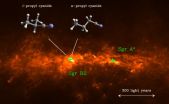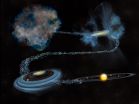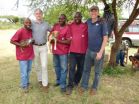(Press-News.org) Ancient, acidic and nutrient-depleted dunes in Western Australia are not an obvious place to answer a question that has vexed tropical biologists for decades. But the Jurien Bay dunes proved to be the perfect site to unravel why plant diversity varies from place to place. Smithsonian Tropical Research Institute scientist Benjamin Turner and colleagues from the University of Western Australia published findings in the Sept. 26 edition of Science showing that environmental filtering—but not a host of other theories—determines local plant diversity in one of Earth's biodiversity hotspots.
Turner and colleagues examined plant communities and soil development across a sequence of dunes ranging in age from a few decades to more than 2 million years. The dunes form as sand piles up along the coastline of Western Australia during periods of high sea level. The youngest dunes contain abundant soil nutrients but are home to relatively few plant species, whereas the oldest dunes have some of the most infertile soils in the world yet support many species of plants.
The differences in diversity of plants on the dunes are much better explained by environmental filtering—the exclusion of species from the regional flora that are poorly adapted to local conditions—than by alternative ideas related to competition for resources.
"Ecologists have long sought to understand what explains variation in species diversity among sites," said Helene Muller-Landau, STRI staff scientist. "This elegant study shows that variation in plant species diversity among dunes of different ages, and thus different soils, is explained mainly by variation in the size of the pool of species adapted to these differing conditions." Biogeographical and historical factors, like the total area in the region with similar conditions today and in the past, are primary, while factors such as competition for soil resources are much less important in explaining variation in species diversity.
"A number of mechanisms have been proposed to explain plant diversity along resource gradients, but they have not previously been tested simultaneously," Turner said. "The Jurien Bay chronosequence allowed us to do this, and gave a clear result—that local plant diversity is explained primarily by environmental filtering from the regional flora."
Jurien Bay is a rare example of a long-term chronosequence of soils in a species-rich ecosystem, making it an ideal location to test biodiversity theory.
"A challenge now is to examine this process along chronosequences in other species-rich ecosystems," Turner said. "Unfortunately, there are as yet no long-term soil chronosequences with intact vegetation known under diverse lowland tropical forest."
Turner expects the findings to spark a flurry of debate, but emphasizes that the research does not seek to explain the maintenance of biodiversity within individual communities, only how it varies among communities. Theories such as negative density dependence—that natural enemies maintain diversity in species-rich plant communities—are not challenged by this work, he said.
"It's important to recognize that resource competition or other mechanisms can still maintain diversity," Turner said. "But in terms of explaining why plant diversity varies from place to place, our results indicate that environmental filtering is the overriding explanation. "
"I suspect that the answers will be different for different ecosystems in different places," Muller-Landau said. "Here in Panama, and throughout the tropics, wet forests tend to have much higher species diversity than dry forests. This pattern is generally explained in terms of differences in ecological conditions, especially wet forests being more conducive to pathogen attack. But we're not sure if this is the correct explanation. A study like this would help us to sort that out."
INFORMATION:
Smithsonian Tropical Research Institute
https://www.youtube.com/watch?v=M9JDSIwBegk
Laliberté, E., Zemunik, G., Turner, B.L. (2014) Environmental filtering explains variation in plant diversity along resource gradients. Science 345 (6204; 26th September).
Dunes reveal biodiversity secrets
2014-09-25
ELSE PRESS RELEASES FROM THIS DATE:
Tropical disease prevalence in Latin America presents opportunity for US
2014-09-25
HOUSTON – (Sept. 25, 2014) – Recently published prevalence estimates of neglected tropical diseases (NTDs) in five Latin American countries — Bolivia, Cuba, Ecuador, Nicaragua and Venezuela — could suggest a new direction for United States foreign policy in the region, according to a tropical-disease expert at Rice University's Baker Institute for Public Policy.
Dr. Peter Hotez, the fellow in disease and poverty at the Baker Institute, outlined his insights in a new editorial, "The NTDs and Vaccine Diplomacy in Latin America: Opportunities for United States Foreign Policy," ...
Stem cell transplant does not cure SHIV/AIDS after irradiation of infected rhesus macaques
2014-09-25
A study published on September 25th in PLOS Pathogens reports a new primate model to test treatments that might cure HIV/AIDS and suggests answers to questions raised by the "Berlin patient", the only human thought to have been cured so far.
Being HIV-positive and having developed leukemia, the Berlin patient underwent irradiation followed by a bone-marrow transplant from a donor with a mutation that abolishes the function of the CCR5 gene. The gene codes for a protein that facilitates HIV entry into human cells, and the mutation—in homozygous carriers who, like the donor, ...
Interstellar molecules are branching out
2014-09-25
Scientists from the Max Planck Institute for Radio Astronomy (Bonn, Germany), Cornell University (USA), and the University of Cologne (Germany) have for the first time detected a carbon-bearing molecule with a "branched" structure in interstellar space. The molecule, iso-propyl cyanide (i-C3H7CN), was discovered in a giant gas cloud called Sagittarius B2, a region of ongoing star formation close to the center of our galaxy that is a hot-spot for molecule-hunting astronomers. The branched structure of the carbon atoms within the iso-propyl cyanide molecule is unlike the ...
Stone Age site challenges old archaeological assumptions about human technology
2014-09-25
The analysis of artifacts from a 325,000-year-old site in Armenia shows that human technological innovation occurred intermittently throughout the Old World, rather than spreading from a single point of origin, as previously thought.
The study, published today in the journal Science, examines thousands of stone artifacts retrieved from Nor Geghi 1, a unique site preserved between two lava flows dated to 200,000–400,000 years ago. Layers of floodplain sediments and an ancient soil found between these lava flows contain the archaeological material. The dating of volcanic ...
Earth's water is older than the sun
2014-09-25
Washington, D.C.—Water was crucial to the rise of life on Earth and is also important to evaluating the possibility of life on other planets. Identifying the original source of Earth's water is key to understanding how life-fostering environments come into being and how likely they are to be found elsewhere. New work from a team including Carnegie's Conel Alexander found that much of our Solar System's water likely originated as ices that formed in interstellar space. Their work is published in Science.
Water is found throughout our Solar System. Not just on Earth, but ...
Agonizing rabies deaths can be stopped worldwide
2014-09-25
The deadly rabies virus--aptly shaped like a bullet-- can be eliminated among humans by stopping it point-blank among dogs, according to a team of international researchers led by the Paul G. Allen School for Global Animal Health at Washington State University.
Ridding the world of rabies is cost-effective and achievable through mass dog vaccination programs, the scientists report in a paper that appears in the Sept. 26 issue of Science magazine. What's more, they write, because infections occur as a result of interactions between animals and people, a "One Health" approach ...
Heritage of Earth's water gives rise to hopes of life on other planets
2014-09-25
A pioneering new study has shown that water found on Earth predates the formation of the Sun – raising hopes that life could exist on exoplanets, the planets orbiting other stars in our galaxy.
The ground-breaking research set out to discover the origin of the water that was deposited on the Earth as it formed.
It found that a significant fraction of water found on Earth, and across our solar system, predates the formation of the Sun. By showing that water is 'inherited' from the environment when a star is born, the international team of scientists believe other exoplanetary ...
Harvesting hydrogen fuel from the Sun using Earth-abundant materials
2014-09-25
VIDEO:
Science published on Sept. 25, 2014 the latest developments in Michael Grätzel's laboratory at EPFL in the field of hydrogen production from water. By combining a pair of perovskite solar...
Click here for more information.
The race is on to optimize solar energy's performance. More efficient silicon photovoltaic panels, dye-sensitized solar cells, concentrated cells and thermodynamic solar plants all pursue the same goal: to produce a maximum amount of electrons ...
Innovative Stone Age tools were not African invention, say researchers
2014-09-25
A new discovery of thousands of Stone Age tools has provided a major insight into human innovation 325,000 years ago and how early technological developments spread across the world, according to research published in the journal Science.
Researchers from Royal Holloway, University of London, together with an international team from across the United States and Europe, have found evidence which challenges the belief that a type of technology known as Levallois – where the flakes and blades of stones were used to make useful products such as hunting weapons – was invented ...
New discovery could pave the way for spin-based computing
2014-09-25
PITTSBURGH—Electricity and magnetism rule our digital world. Semiconductors process electrical information, while magnetic materials enable long-term data storage. A University of Pittsburgh research team has discovered a way to fuse these two distinct properties in a single material, paving the way for new ultrahigh density storage and computing architectures.
While phones and laptops rely on electricity to process and temporarily store information, long-term data storage is still largely achieved via magnetism. Discs coated with magnetic material are locally oriented ...




